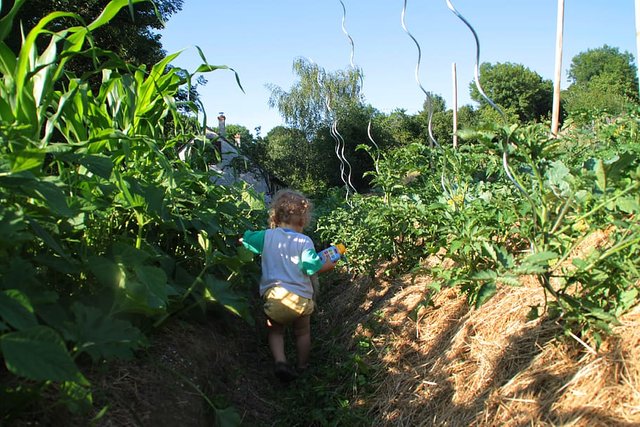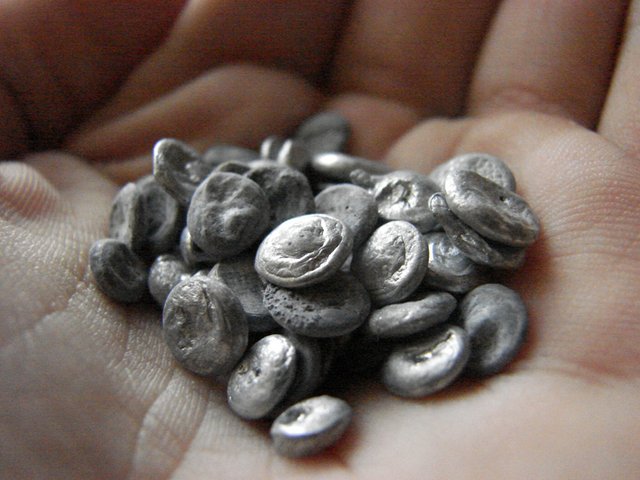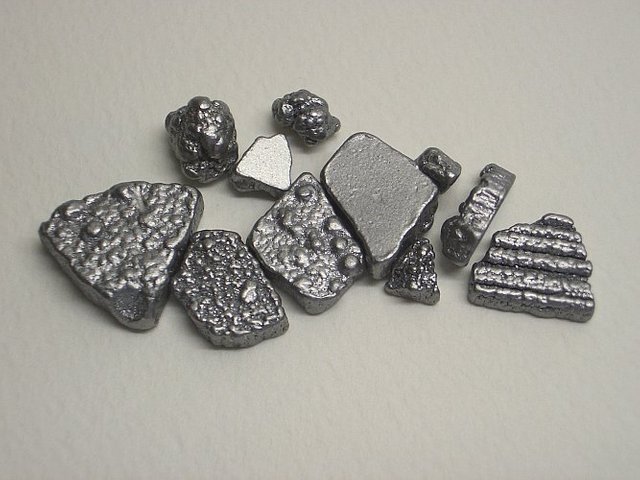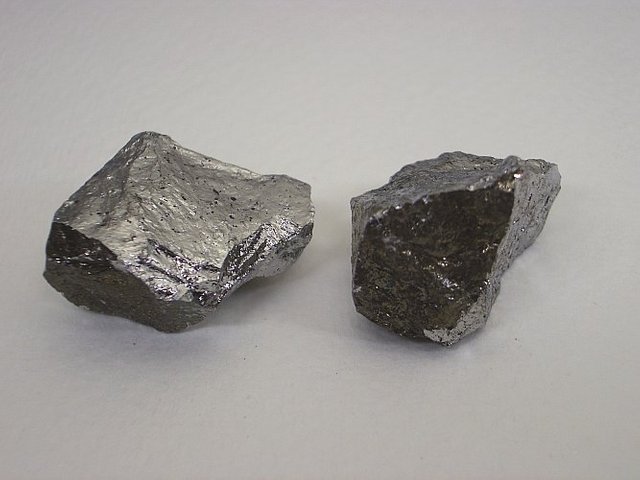Permaculture - zinc, calcium, iron, manganese, sulfur and other elements (lesson 11)
Intro
We already described seven microelements in the two previous lessons. Now it's time to write few words about other useful or harmful elements present in the soil. I will focus on five, describing them in detail, but below you will find two tables with a list of less important elements with few words of explanation of how do they affect our plants in the garden.
ZINC
The average zinc content in soils is 10-80 mg for every kg of soil. Zinc deficiencies usually occur in sandy and alkaline soils (excessively limed) or overfertilized with phosphorus fertilizers
Plants particularly sensitive to zinc deficiency include hops, corn, flax, beans, soybeans, broad beans, fruit trees, grapevines
Plants that are particularly sensitive to excess zinc are cereals
A high concentration of violets and rue may indicate underground zinc deposits.
Zinc is responsible for the hormonal balance of plants, participates in the synthesis of chlorophyll and vitamins, and the construction of proteins. It also influences the growth of the plant.
Zinc deficiencies:
- older leaves have whitish discoloration on both sides at the base
- leaf dwarfism, reddening of veins and edges.
- chlorotic, mottled spots between the veins on younger leaves
- the sections between the buds are visibly shortened
- the plant produces sparse, small, and distorted fruits
Response:
- regulating the pH of the soil. The highest bioavailability of zinc is characterized by pH 4.5 - 6.0, and then it gradually decreases. Zinc deficiency practically does not occur in soils with a pH lower than 6.0.
- make sure the soil does not contain too much phosphorus
- zinc can be introduced through all forms of natural fertilizers (see previous lessons dedicated to individual fertilization methods). The average amount of zinc in a kilogram of manure is 350 mg
- zinc oxide can be used on acidic soils and zinc sulfate on alkaline soils, the treatment should be repeated every 7-10 years
Excess zinc
- chlorosis of young leaves, often combined with the red color of the vascular bundles of older leaves
- weaker growth
- slow root growth in length
- impairs iron uptake by the plant, indicates deficiencies of this nutrient
Response
- make sure that the soil is not deficient in phosphorus
- increase the content of organic matter in the soil, as organic matter reduces the absorption of zinc
- if the above methods do not help, soil rehabilitation is required
CALCIUM
In an ideal soil, the ratio of calcium, magnesium, potassium, and sodium is 50: 35: 6: 5. Remember that potassium increases the amount of sodium and sodium reduces the amount of calcium. The number of magnesium ions should be less than the number of lime ions.
Since calcium is directly responsible for the pH of the soil and, indirectly, the absorption of virtually all minerals. Plants requiring alkaline soil will be sensitive to deficiency, and those that grow better in acidic soils to excess.
Calcium activates soil life, helps to maintain the lumpy structure, and increases the pH of the soil. In soils rich in this macroelement, the leaching of other micro and macro elements is limited. Calcium is important for the stability of plant tissues, it is part of the cell walls and increases their disease resistance. It has a positive effect on the intensity of many processes, such as nitrogen fixation from the air by legumes, nitrification, ammonification, etc.
Calcium deficiencies:
- the soil is acidic and has a poor structure
- the crops are of lower quality and there are fewer of them
- deformation of younger leaves
Response:
- mainly introduce into the soil together with mineral fertilizers - dolomite, marl, and others (see: a lesson about mineral fertilizers), and in limited amount with manure (see: a lesson about manure) or compost, especially containing algae.
- Basalt dust works best as a fertilizer in tropical soils.
ATTENTION!
It is impossible to improve soil pH overnight. Visible changes in soil pH usually take place in the 2nd - 3rd year. The positive effect of liming on soil fertility and yields lasts for 3-5 years. Usually, in standard agriculture, the fertilization process is repeated every 4 years.
As I mentioned in one of the previous lessons, after applying fertilizers with lime, you should wait at least 3-4 weeks before planting the plants.
Liming the field and applying manure in the same year are ineffective. Lime accelerates nitrogen volatilization into the atmosphere and the decomposition of organic matter. When the soil in the garden has a pH lower than 6.0 - let's apply liming, and the manure should be moved to the next year, when the soil has a pH above 6.5, do the other way around.
Excess Calcium:
- plant dies
- disrupted intake of water and other ingredients.
Response:
- calcium absorption is limited by sodium
- the pH of the soil can be lowered with sulfur or, for example, by mulching with conifers (needles, sawdust from coniferous wood)
IRON
Iron in small amounts is found in all types of soil. It is the fourth most frequent element on the earth. Deficiencies concern only digestible forms and are more common in sandy, carbonate, and alkaline soils and with excess calcium in the soil.
Fruit trees, most vegetables, corn, and flax are particularly sensitive to iron deficiencies in the soil.
Iron is one of the main elements of chlorophyll. It has a great influence on the process of photosynthesis and respiration and helps in the processes of nitrogen fixation from the air. It plays an important role in nitrogen metabolism and the metabolism of nucleic acids.
Iron deficiencies:
- interveinal chlorosis on young leaves (as opposed to magnesium deficiency which has the same symptoms but on older leaves)
- fruit bud development disorders
- inhibition of plant growth
- with a severe deficiency, the tissue of the entire plant dies
- a deficiency may cause manganese to reach toxic levels
Response:
- check the soil pH (it should be in the range of 5.0-7.5), the amount of calcium, manganese, copper, and zinc in the soil (excess of each inhibits the absorption of iron). Make sure the plant is in a well-lit area and the soil is properly drained.
- use fertilizers with a high sulfur content
- bury small iron products in the soil at several distant places
- use peat, leaf, or bark composts, preferably with the addition of low-calcium mineral flour
- use manure (depending on the type, manure contains up to 0.5 g of iron per kilogram)
Iron excess:
- reduction of phosphorus and manganese uptake
- overly discolored and dry leaves
- inhibition of plant growth
- browning of the roots
Response:
- regulation of assimilable forms of iron by applying higher doses of calcium, manganese, copper, or zinc in fertilizers
MANGANESE
Manganese deficiencies are found in neutral and alkaline soils, mostly heavy, organic, and rich in calcium. May be toxic on soils with a pH below 5.0. As availability is favored by moisture in the soil, deficiencies may be more common in dry years.
Potatoes and oats are the most sensitive to deficiencies.
Manganese is responsible for the nitrogen and hormonal balance of plants stimulates phosphorus uptake and influences the development of the root system. It increases the plant's immunity and reduces the risk of infection with potato scab, beetroot brush, powdery mildew, or root rot. Its optimal amount ensures a high level of vitamins and sugars in the fruit.
Manganese deficiencies:
- young spotted leaves
- chlorotic mosaics of dicotyledons
- in apple trees, point chlorosis between the main leaf veins. The affected fragments die and leave holes with time
- cereals with streaky chlorosis on the leaves
- inhibition of growth and leaves falling off, dying of their tips
Response:
- first, lowering the pH with sulfur fertilizers (manganese absorption from 7.0 and increases with acidity, but exceeds the dangerous level at pH 5.0)
- use any type of natural fertilizers, for example, average manure contains 640 mg of manganese for each kilogram
- as the last treatment, when everything else failed, you can use a very dilute solution of manganese sulfate
Manganese excess:
- most often on acidic soils
- brown, almost black spots on petioles and shoots
- sometimes chlorosis and leaf edge dieback
- worse absorption of iron, magnesium, and calcium
Response:
- increasing the pH of the soil by using natural fertilizers with high calcium content.
SULFUR
In dry areas, sulfur is used to lower the soil pH. Its deficiency is very rare, mostly in sandy soils and in wet subtropical regions, as sulfur can leach out. Leaching is limited by a large amount of clay and iron oxides in the soil and by kaolinite.
The annual demand for this macroelement varies between 15g-80g per 10m2 (depending on the species of cultivated plants)
Sulfur affects the absorption of zinc, iron, and other microelements, regulates soil pH, is a building block of plant tissue, has a beneficial effect on water management, improves plant resistance and its taste/aroma.
Sulfur deficiency:
- low shoot growth, and roots
- plant stiffness and brittleness, low growth in thickness
- accelerated and excessive wood stalks
- drying of the side parts of the leaf blades, turning yellow or light green. Young leaves are affected first
Prevention:
- use any type of natural fertilizers or selected plant species of green manure, which are pulling the sulfur washed out into the upper layers of the soil (check previous lessons dedicated to those topics)
- pure sulfur can be applied directly to the soil. Do not use pharmacy organic sulfur for fertilization though.
Excess:
- very spicy plant flavor
- higher content of harmful metals
- soil acidification
NICKEL
Nickel is a heavy metal - its excess is toxic to all living organisms. It is much more dangerous than its deficiency. Nevertheless, it is needed by plants that take fertilizer from urea (e.g. legumes). In addition, it affects the uptake of iron, supports the germination of seeds, especially lettuce, potatoes, oats, and legumes.
Nickel can be incorporated into the soil with any natural fertilizer. A kilogram of homemade compost contains up to 15 mg of this microelement.
The excess of nickel may be heralded by large clusters of whipworms.
OTHER FAVORABLE ELEMENTS
| Element | Description |
|---|---|
| Sodium | Only required in trace amounts, delivered through rain or soil. Its excess is harmful |
| Cobalt | Especially needed by legumes and animals. Sheep droppings are exceptionally rich in cobalt |
| Selenium | Needed in small amounts in the garden and for sheep. Can be supplemented with sea algae. |
| Silicon | An important building block of plant cells, especially grassy plants. Compost with the addition of grasses and cement increases the amount of silicon in the soil. |
| Aluminum | Increases plant resistance to unfavorable weather conditions |
| Vanadium | Legumes have a particularly high demand for vanadium |
| Lit | It is naturally supplemented with compost and manure. Only small amounts are required |
| Fluorine | Beneficial in small amounts, for example, introduced by marine algae fertilizer. It acts as a poison when overdosed. Overdosing in soil occurs in large urban agglomerations. |
| Titanium | Not directly used by plants, but in sandy soils, it is a catalyst for the formation of ammonia which helps plants survive in dry areas. |
POISONS
| Element | Description |
|---|---|
| Aluminum | Toxic. It is found in excess in acid rain and soils contaminated with sulfur, mainly in industrial areas. Small amounts can be mitigated by liming the soil |
| Chrome | Poison for plants and animals. It requires urgent removal from the soil |
| Arsenic | Harmful to plants and animals, it is found in many industrial areas |
| Tin | harmful to plants and humans in larger quantities |
| Iodine | harmful. With high soil content, it can be found in the milk of farm animals |
| Mercury | a harmful element found in acid rain, soils near mines, heavily polluted regions |
| Lead | poison found in large urban clusters and busy roads. It requires a large amount of organic substance to be covered. The greatest pollution occurs in cities, especially in regions with older buildings. You can limit the negative effects by: - preparation of a base for beds made of crushed bricks or gravel - excavation of 30 cm of soil and replacement with composted soil with at least 40% organic matter - if the lead is deposited on vegetables and fruit in the form of dust, washing the plants in the vinegar helps |
| Sulphuric acid | Pollution occurs mainly in swampy areas. It remains harmful to most plants. You can get rid of it by draining the land, applying alkaline fertilizers such as ash or lime |
| Chlorine | Harmful to plants and people who eat them. Pay attention to the chlorine content of the water you use for watering. If the standards have been exceeded, urgently report this fact to the health and safety department and refrain from drinking tap water, or even bathing in it. |
All my lessons are shared totally for free with a CC-0 license (which means you can copy my text and share it wherever you want to, without the need to mark me as an author). I hope it will bring you joy.
Previous lessons can be read here:
Fertilizers
2 - types of manure and when to use it
3 - Compost. Basics
4 - advanced composting
Soil and minerals
9 - Nitrogen, Phosphorus, Potassium
10 - Boron, Molybdenum, Copper, Magnesium
Thank you for reading,
@papi.mati





The lessons is the best for us.
The elements is very essential for plants and trees.
Thank you for useful post.
I'm glad to hear you enjoyed my lesson. Good day to you!
Thanks
Excelente! Muchas gracias por compartir :)
Upvoted!